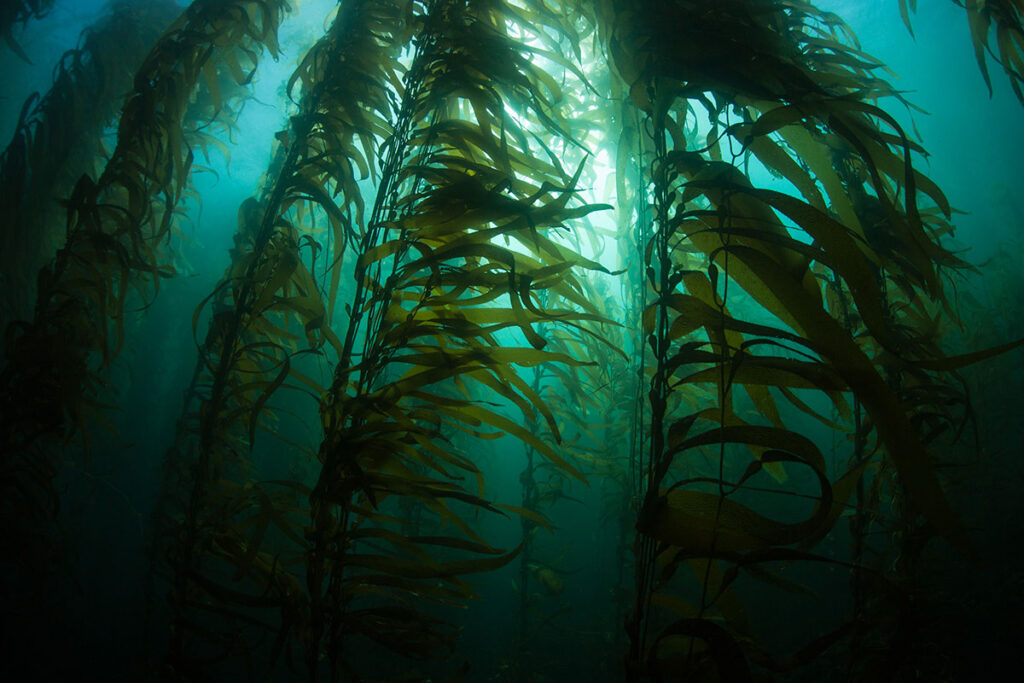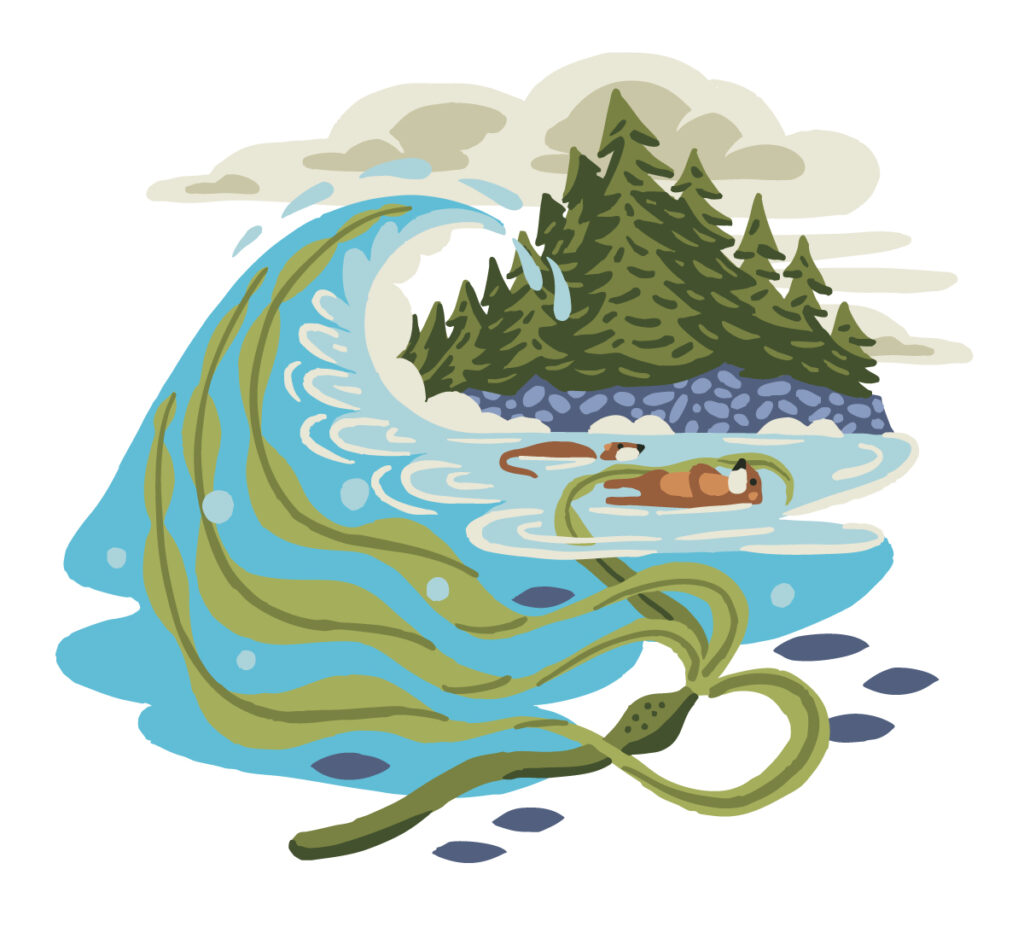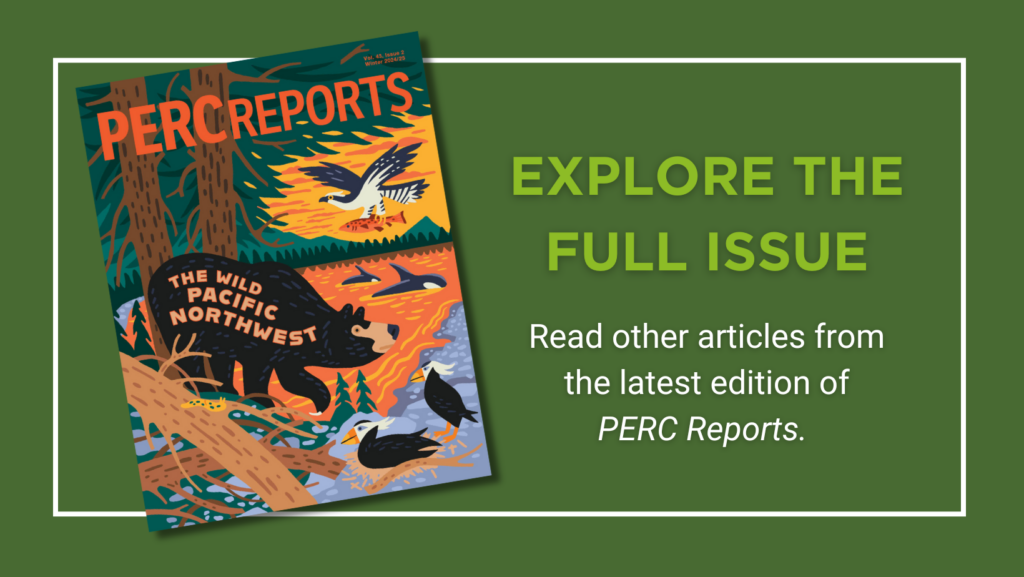
This special issue of PERC Reports explores the creative ideas to address the unique conservation challenges of the Pacific Northwest.
An old-growth forest anchored by deep roots rises 175 feet toward sunlight, with leathery, dark green fronds spreading into a gently swaying canopy. On those fronds so much depends. Each square kilometer of this Pacific Northwest forest annually inhales enough CO2 to sequester 1,000 metric tons of carbon, then exhales five million cubic meters of life-giving oxygen in a climate-stabilizing exchange. Since time immemorial, the shadows of this nutrient-rich forest have provided a three-dimensional habitat for more than 1,000 plant and animal species, boosting local biodiversity ninefold wherever it is left intact. Welcome to the Pacific’s hidden underwater forest—one made entirely of kelp.
Unfortunately, this forest primeval—an ancient interwoven 1,500-square-mile ecosystem that once ranged from Mexico to Alaska and grew thickest in the wild coast from Monterey to Mendocino—has been reduced to scattered fragments of its former glory. Only this time, we can’t blame chainsaws. The last isolated patches of America’s giant and bull kelp forests are instead being cut down in their prime by the amoral teeth of a lowly echinoderm known as the purple sea urchin.
With lavender spines gently trundling along, a solitary urchin looks like a tiny ocean hedgehog. It’s almost … cute. But over the last decade, its population has exploded. Tens of millions of the menacing prickly hunters scour the sea floor off Northern California alone, having devoured 95 percent of the region’s bull kelp beds, always ravenously searching for more.
People versus urchins seems like a lopsided fight. And indeed, our species has already sallied forth clad in scuba gear using hammers to smash purple urchins in an effort to save Pacific kelp. In a recent dive off the California coast, one volunterr referred to it as “ecologically santioned mayhem.”
This Pacific Coast population bomb detonated when overlapping forces conspired to knock out the urchin’s main predator: the sunflower sea star. Over time, this prolific predator evolved chemical receptors to track down urchins, tube feet to grip and pry them open, and a stomach the star could push out through its mouth to envelop and digest spiny urchins externally. Natural selection optimized a dynamic balance. Unfortunately, carbon emissions have both heated up the ocean and made it more acidic, crippling the sunflower sea star’s immune system. This weakened state leaves them vulnerable to wasting syndrome, a disease that causes lesions, tissue decay, and massive die-offs. Rescued from their ancient Darwinian nightmare, purple sea urchins happily ballooned to densities 60 times higher than normal.
Yes, nature abhors a vacuum. But other past predators of purple sea urchins that might move in—lobsters, crabs, sheephead, wolf eel—all remain too limited in range and diminished in number. Why not bring back the urchin’s apex predator, the outrageously photogenic sea otter? Boosting tourism while decimating a menace—a single otter can eat 10,000 urchins a year—sounds like such a natural fix that the U.S. Fish and Wildlife Service is exploring the idea. Yet it would be a complicated, uncertain gamble (see “A Coastal Comeback,” p. 12). Establishing a robust population of reintroduced sea otters would cost up to an estimated $43 million over 13 years—and even then, there’s no guarantee the adorable mammal will stick around to fatten up on purple urchins, rather than disperse, starve, or get munched by great white sharks.
That leaves just one prehistoric carnivore who has devoured purple urchins for millennia: us. Native Americans had for at least 3,000 years helped keep urchin populations in check, until coastal tribes were displaced by European settlers who farmed their protein sources. Now, a cultural confluence of indigenous foraging and Western palates might once again write the recipe for restoring kelp forests—one bite at a time.

A Prickly Problem
People versus urchins seems like a lopsided fight. And indeed, our species has already sallied forth clad in scuba gear using hammers to smash purple urchins in an effort to save Pacific kelp. In a recent dive off the California coast, one volunteer referred to it as “ecologically sanctioned mayhem.” (She elaborated: “If you’re angry, it’s a cathartic way to get it all out.”)
It’s an underwater version of whack-a-mole against a prickly invasion so overwhelming it feels Sisyphean. Not only do urchins thrive in a cold, turbulent place hostile to our presence. But even up close, while weighing in at no more than 3.5 ounces, and reaching just four inches in diameter, the simple-minded and slow-moving purple urchin is also far from helpless. Its bristling sharp spines and smaller, pincer-like pedicellariae can easily puncture our skin and inject venom, a painful deterrent that evolved to protect the urchin’s interior, which holds an unusually nutritious treasure. The reproductive organ is known by its Japanese name, uni—AKA, urchin gonads.
If those two words don’t trigger your salivary glands, consider their appearance. Held under a bright light these soft, fleshy lobes glisten with a slimy, mucous-like coating. The texture is spongy and gelatinous, with a slightly lumpy surface. Cut open, the gobs ooze a thick, viscous liquid.
Could you stomach this gooey substance? The stakes go beyond a shallow gastronomic stunt to determine the fate of life on earth, at least in this corner of it.

“If it’s bad for nature but tastes good to us, you’ve got a problem that solves itself,” my late mentor and former PERC Senior Fellow Bobby McCormick told me more than a decade ago. McCormick was a legendary economist at Clemson University who led PERC’s summer program for environmental entrepreneurs like me. Back then we wrestled with the problem of invasive lionfish, which had escaped aquaria to wreak havoc on Caribbean coral reefs, much as invasive sea lamprey caused mayhem in the Great Lakes.
McCormick’s theory, given our species’ insatiable hunger and naked self-interest: Adopt a laissez-faire approach that gives fishermen free reign to sell as many of each ocean troublemaker as they can catch, supply restaurants and markets with nutritious protein, and save marine ecosystems in the process. It’s a lovely strategy, beautiful in its simplicity. And the “devour our way out of the kelp forest crisis” strategy may indeed work here if it can align economic and ecological goals.
So, can the purple urchin’s voracious appetite be contained by our own? Two Pacific relatives suggest a range of what’s possible. Southward along the California coast, dozens of divers seeking red urchin’s aka uni can harvest 100 to 10,000 pounds a day, earning $1 to $3 a pound in a volatile, nascent $5 million fishery. In Hokkaido, Japan, the short-spine urchin fishery for premium bafun uni is a mature, $100-million industry that supports thousands of workers across fishing, processing, and distribution.
But the global supply from either fishery can’t really grow due to finite range and habitat. By contrast, the current supply of purple urchin is virtually unlimited. Which raises the other market dynamic: potential demand.

Acquiring A Taste
For those raised on crispy Filet-o-Fish or canned Chicken of the Sea, this unusual seafood delicacy will be an acquired taste. But your fearless correspondent felt obliged to do his duty. While purple urchin was nowhere yet on nearby menus, I took my daughter to a sushi bar and ordered those two closest relatives—aka and bafun uni.
Once served, I procrastinated, then opened my mouth and closed my eyes and tried each one in turn on my tongue. With a buttery texture, bafun uni combines a mineral, briny sweetness with that fifth savory taste, umami. Aka uni is similar, only creamier. Both taste like the ocean. Try one and the lingering sensation makes it hard to settle for relatively bland California rolls again—if you can ignore uni’s hefty price tag.
Most can’t. But of course, that’s good news. If local demand is slow to materialize for purple urchin’s smaller-sized uni and unfamiliar taste, appetites from Asia and indeed worldwide only keep swelling in what is already a wildly lucrative industry. Extracted and cleaned, high-grade fresh urchin gonads wholesale for $125 per pound. High-end sushi bars can charge $20 to $40 for a dab of uni on a single piece of nigiri. The quest to satisfy human desire for that taste has already created a $300- to $500-million global market.
While currently undeveloped, a purple urchin fishery could compete for a sliver of that pie. But to become commercially viable, it needs a marketing makeover. Give it an eye-catching, Japanese color-appropriate name: murasaki uni. Elevate it: a rare luxury harvested from California’s cleaner, colder northern waters. Stress unique health benefits: rich in heart-healthy omega-3 fatty acids and immune-boosting micronutrients. Virtue signal: order the only seafood that uniquely helps replenish pure ocean habitats.
Restaurants along the shoreline of Highway 1 have started this effort, cultivating early adopters. For his Harbor House guests, executive chef Matthew Kammerer whips purple urchin gonads into custards, pasta sauces, and candied butter. Surrounding communities have launched the annual Mendocino Coast Purple Urchin Festival, with cooking demonstrations and events harnessing appetites on behalf of the majestic kelp forests they dub “Sequoias of the Sea.”
Such local, bottom-up activity is an essential start, but they’re still baby steps. A random weekend diver may drop off a bag of her afternoon’s harvest to a restaurant’s back door hours before opening. But skilled labor, harvesting from boats or shore, drives up marginal costs of bagging urchin, limiting the number of domestic buyers prepared to pay for it. Even when entrepreneurs dabble in purple urchin “ranching”—collecting, feeding, and fattening up big individuals in landlocked holding tanks—it does little for offshore kelp in the wild.
Bringing back the giant and bull kelp forests to their historic range and density across 1,000 square kilometers could absorb 1.7 million metric tons of the world’s annual CO2 emissions.
That’s why accelerating these efforts may require a combination of public and private investment on par with the sea otter’s $43 million reintroduction expense. How can economies of scale take root, providing retailers and wholesalers with a safe, healthy, reliable, and transparent global supply chain that would extract enough purple urchins to restore the kelp forest ecosystem?
One approach is to keep eyes on the larger ecological outcome. A commercially viable murasaki uni fishery could generate hundreds of jobs and several million dollars in revenues for local coastal economies. And that ignores global benefits. Bringing back the giant and bull kelp forests to their historic range and density across 1,000 square kilometers could absorb 1.7 million metric tons of the world’s annual CO2 emissions. California’s cap-and-trade program alone pays a conservative market price of $40 per ton and rising. That means a fishery that harvests urchin to rebuild kelp beds could help generate another $70 million—every year.

In sum, the potential gains—in money, animal protein, and climate stabilization—are massive. Yet reinserting our hungry and avaricious species into the equation raises the risk of excessive effort. On America’s other coastline, Maine offers a cautionary tale, where overharvesting urchins in the 1980s and ‘90s to meet global uni demand brought about that fishery’s collapse. The once complex and self-regulating marine ecosystem flipped into the opposite simplified seascape—overly dense kelp patrolled by hungry lobster and Jonah crabs, making it impossible for urchins to ever come back. How can the Pacific avoid the Atlantic’s fate?
To answer, we might draw on lessons from other Pacific Coast sources of seafood—whiting, groundfish, halibut, black cod, pollock, king crab—that have transitioned to rights-based fishery management, a collaborative system known as “catch shares.” In each case, public and private stakeholders set clear conservation and community goals (e.g., restore kelp forests, generate a local seafood exports economy), define the fishery’s scope (purple urchin), allocate quota (with set asides for coastal fishers or Native tribes and concentration limits to prevent market dominance), determine science-based catch limits (harvesting enough uni to generate profits while avoiding urchin collapse), establish secure and exclusive access rights for participants (not permanent, but long-term enough to trade quota and attract investors), and create strong accountability measures (transparent tracking, tracing, and monitoring) to ensure compliance.
The advantage of such a system is that it is flexible and versatile. It spells out in advance the rights, risks, responsibilities, and rewards for all relevant stakeholders. In the case of purple urchins, for example, a bonus benefit for all stakeholders invested in the urchin catch share could be carbon credits captured through expansion of kelp forest to its earlier expanse, earned and paid in perpetuity. And while the design would involve federal oversight to establish caps by applying objective scientific research, the process would ensure long-term certainty, ownership, and economic incentives for local communities, which builds trust from below.
It’s not about bashing urchins with hammers as an enemy, or offshoring responsibility for reducing emissions to charismatic sea otters. It’s about harnessing our appetite and ingenuity to bring balance back to the Pacific’s underwater old-growth forests. By creating the right incentives—turning a prickly pest into a prized delicacy—we can align market forces, local communities, and conservation efforts to restore the majestic kelp forests. It’s a strategy rooted in resilience, driven by a simple truth, wisely noted by my mentor Bobby all those years ago: When nature is on the menu, we all have a stake in the outcome.




